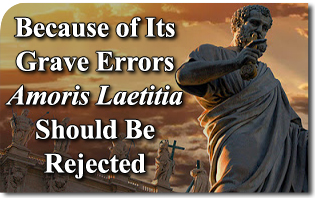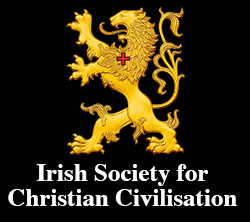
“Thou shalt not commit adultery.” (Exod. 20:14)
“Everyone who divorces his wife and marries another commits adultery, and the one who marries a woman divorced from her husband commits adultery.” (Luke 16:18)
Since the family is the basic cell of society, when it is in crisis, all of society is dragged down with it.
Today, the family is shaken above all by the crumbling certainty in marriage’s indissolubility, and the role this indissolubility plays in family life and in the education of children. The evil fruits of the family crisis are the staggering numbers of those who divorce, downgrading their sacred marriages into temporary living arrangements.
Even among Catholics, indissolubility is evanescent, as the numbers of divorces and nullity decrees increase, due in no small measure to the mischief of liberal theologians and pastors. Indeed, rather than laboring to restore the true meaning of marriage, reminding the faithful about the Church’s perennial and immutable teaching in this regard, they lull consciences to sleep, misleading many who live in an objective state of mortal sin.
Regretfully, in its insinuations, ambiguities, omissions, and one-sidedness, instead of buttressing the sacred institutions of marriage and the family, Amoris Laetitia contributes to their disintegration.
Some have pointed out that Amoris Laetitia also has many good things. In this, however, one must always remember that good comes from the integrity of a cause and is corrupted by any defect. Evil and error when mixed with good and truth are more harmful than when alone. For as Pope Leo XIII (1878-1903) reminds us.
There can be nothing more dangerous than those heretics who admit nearly the whole cycle of doctrine, and yet by one word, as with a drop of poison, infect the real and simple faith taught by our Lord and handed down by Apostolic tradition.[1]
I. Is It Even Licit to Deal with This Issue?
While expounding on related topics, Arnaldo Vidigal Xavier da Silveira observed:
A Catholic who loves the Papacy and is thus keenly protective of the monarchic character of the Church could ask us a preliminary question: Is it licit to delve into such matters? Would it not be more pious to accept as infallible everything that the Popes and also the bishops say?
We would answer that the faithful should not look at the Church as Our Lord Himself did not make it. If there are doubts about such a fundamental point of Catholic doctrine, it is the mission of Catholic publications to clarify them, for Church doctrine is not esoteric.[2]
It is in this spirit, that we will now analyze aspects of this important document of the Pope’s Ordinary Magisterium.
II. The “Kasper Thesis”
The Post-Synodal Apostolic Exhortation Amoris Laetitia (henceforth “AL”)[3] is the conclusion of heated discussions among theologians, cardinals, bishops, and laity which began with the speech of Walter Cardinal Kasper at the February 2014 Extraordinary Consistory, continued at October 2014’s Third Extraordinary General Assembly of the Synod of Bishops, and then October 2015’s Fourteenth Ordinary General Assembly of the Synod of Bishops.
What shocked Catholic clergy and laity was the fact that in his speech — which Pope Francis praised as “serene theology,” a way of “doing theology while kneeling”[4] — Cardinal Kasper proposed something contrary to the words of Our Lord Jesus Christ in the Gospel and the whole tradition of the Church, something contrary to the warnings of Saint Paul, namely, that divorced and civilly remarried Catholics be allowed to receive Holy Communion.[5]
In addition to books and articles of great historical and theological weight written by cardinals, bishops, priests and laymen refuting the “Kasper thesis,” over 800,000 signatures were collected around the world by Filial Appeal, a coalition of TFPs and other organizations. Over 200 cardinals and bishops also signed this Filial Appeal asking the Pope to say a clarifying word that would dispel so much confusion.
III. Is God’s Law Not Applicable to All?
Ultimately, AL accepts the “Kasper thesis,” not just in note 351 of paragraph 305, but throughout the Exhortation’s confused and ambiguous line of reasoning.[6]
Leaving aside the document’s sociologism, its theological-moral argumentation is based on the principle that Divine Law and Natural Law cannot be applied universally to all persons because these Laws have to be adapted to the specific circumstances of the lives of each individual and their subjective consciences. AL downplays the normative character of Natural Law, presenting it only as a “source of objective inspiration for the deeply personal process of making decisions” (n. 305).
Examples being so numerous that it would be impossible to cite them all herein, we limit ourselves to this quote summarizing the whole argumentation:
If we consider the immense variety of concrete situations such as those I have mentioned, it is understandable that neither the Synod nor this Exhortation could be expected to provide a new set of general rules, canonical in nature and applicable to all cases. What is possible is simply a renewed encouragement to undertake a responsible personal and pastoral discernment of particular cases, one which would recognize that, since “the degree of responsibility is not equal in all cases”, the consequences or effects of a rule need not necessarily always be the same.(n. 300)
According to AL, the factors that excuse people from the guilt of sin in the internal forum are such, that remarried divorcees and cohabiting couples should no longer be presumed to be public sinners:
Hence it is [sic] can no longer simply be said that all those in any “irregular” situation are living in a state of mortal sin and are deprived of sanctifying grace. (n. 301)
Because of forms of conditioning and mitigating factors, it is possible thatin an objective situation of sin — which may not be subjectively culpable, or fully such — a person can be living in God’s grace, can love and can alsogrow in the life of grace and charity, while receiving the Church’s help to this end. (n. 305)
“No longer”? What is it that no longer permits us to presume that “irregular” couples are public sinners? Is it something new in relation to the traditional doctrine and pastoral practice of the Church?
During his return flight from Greece, Pope Francis was asked by a journalist if there are now new concrete possibilities that did not exist prior to the publication of AL. The answer of the Pope was emphatic: “I can say yes; period.”[7]
But how can we explain this change, when we think of the words of the Divine Redeemer: “Heaven and earth shall pass, but my words shall not pass” (Matt. 24:35)?
IV. Paving the Way for the Giving of Holy Communion to Adulterers
If such persons are in the state of grace while still adulterous, why should they not receive Holy Communion? With this sophistry, in a footnote to that paragraph, AL concludes they can receive communion, “in certain cases”:
In certain cases, this can include the help of the sacraments. Hence, “I want to remind priests that the confessional must not be a torture chamber, but rather an encounter with the Lord’s mercy” (Apostolic Exhortation Evangelii Gaudium [24 November 2013], 44: AAS 105 [2013], 1038). I would also point out that the Eucharist “is not a prize for the perfect, but a powerful medicine and nourishment for the weak” (ibid., 47: 1039). (n. 305, footnote 351)
Despite the footnote’s lack of clarity, if we consider it in the context of paragraph 305—which deals with irregular couples—it becomes clear that “the weak” who must be helped with the sacraments are these illegitimate couples.
Also that the affirmation that Holy Eucharist is not a prize “for the perfect,” (those who are in state of grace), but a remedy “for the weak,” it follows, logically, that Holy Communion is being offered “in certain cases” to those irregular couples. Now, the argument that the “Eucharist ‘is … a powerful medicine and nourishment for the weak,’” and therefore should be given to people that are “weak” because of sin, was already answered by Saint Thomas Aquinas as follows:
Every medicine does not suit every stage of sickness; because the tonic given to those who are recovering from fever would be hurtful to them if given while yet in their feverish condition. So likewise Baptism and Penance are as purgative medicines, given to take away the fever of sin; whereas this sacrament [of the Holy Eucharist] is a medicine given to strengthen, and it ought not to be given except to them who are quit of sin.[8]
V. Conscience Replaces Moral Law
The AL argumentation above, which attempts to justify giving Holy Communion to people in the state of public adultery, is based on, or rather repeats, the old errors of “Situation Ethics,” that denies the universal application of Moral Laws. “Situation” is AL’s “key word,” and it is used eighty-eight times. “Situation ethics” though, has been condemned countless times by the popes.
For example, Pope Pius XII, in a 1952 speech to the World Federation of Female Catholic Youth, said:
[These new morals] could be called “ethic existentialism.” [They] are not based onuniversal moral lawssuch as the Ten Commandmentsbut on concrete and real conditions or circumstances in which one must actand according to which theindividual consciencemust judge and choose.
[The]new ethics is so contrary to the Catholic faith and principles, that even a child who knows the catechism will realize it.[9]
Also, John Paul II in the Encyclical Veritatis Splendor, mentioning in a footnote the 1956 condemnation of “Situation Ethics” by the Congregation of the Holy Office,[10] explains that,
Conscience thus formulates moral obligation in the light of the natural law: it is the obligation to do what the individual, through the workings of his conscience, knows to be a good he is called to do here and now. The universality of the law and its obligation are acknowledged, not suppressed, once reason has established the law’s application in concrete present circumstances. The judgment of conscience states “in an ultimate way” whether a certain particular kind of behavior isin conformity with the law; it formulates the proximate norm of the morality of a voluntary act, “applying the objective law to a particular case.”
Now then, we read in AL that,
[I]ndividual conscience needs to be better incorporated into the Church’s praxis in certain situations which do not objectively embody our understanding of marriage. (n. 303)
[A] pastor cannot feel that it is enough simply to apply moral laws to those living in “irregular” situations, as if they were stones to throw at people’s lives. This would bespeak the closed heart of one used to hiding behind the Church’s teachings, “sitting on the chair of Moses and judging at times with superiority and superficiality difficult cases and wounded families.” Along these same lines, the International Theological Commission has noted that “natural law could not be presented as an already established set of rules that impose themselves a priori on the moral subject; rather, it is a source of objective inspiration for the deeply personal process of making decisions.” (n. 305)
VI. Omission of Intrinsic Evil
AL also does not mention a fundamental principle of Catholic Morals that is the concept of intrinsic evil, that is, acts that are bad in themselves, independently of the circumstances, as taught by the whole Catholic moral tradition.
The Encyclical Veritatis Splendor, of John Paul II, briefly recalls this fundamental principle of morals:
81. In teaching the existence of intrinsically evil acts, the Church accepts the teaching of Sacred Scripture. The Apostle Paul emphatically states: “Do not be deceived: neither the immoral, nor idolaters, nor adulterers, nor sexual perverts, nor thieves, nor the greedy, nor drunkards, nor revilers, nor robbers will inherit the Kingdom of God” (1 Cor 6:9-10). If acts are intrinsically evil, a good intention or particular circumstances can diminish their evil, but they cannot remove it.[11]
These acts, and adultery is one of them, in themselves cannot be good in any case, no matter the circumstances or intentions with which they are practiced, as Veritatis Splendor also explains:
[A]n intention is good when it has as its aim the true good of the person in view of his ultimate end. But acts whose object is “not capable of being ordered” to God and “unworthy of the human person”are always and in every case in conflict with that good.[12]
VII. Is Adultery Analogous to Marriage?
An analogy is a relationship established between different realities which nevertheless have something in common. Thus, some analogy exists between the state of adultery or concubinage and that of marriage since in each case a man and a woman live together in a state of intimate communion.
But from this material analogy one cannot draw a moral conclusion about the state of adultery and legitimate marriage because, although they have something in common from the material point of view, they are two different and opposite moral realities: one virtuous and the other vicious. As Saint Thomas says, “in respect of that which belongs to the essence of virtue directly, its contrary is vice.”[13]
As Saint Thomas says, “in respect of that which belongs to the essence of virtue directly, its contrary is vice.”
Although AL recognizes that there is no analogy possible between the so-called same-sex “marriage” and true marriage (n. 251), after speaking of the Christian ideal of marriage, it says this about the state of adultery and concubinage:
Some forms of union radically contradict this ideal, while others realise it in at leasta partial and analogous way. The Synod Fathers stated that the Church doesnot disregard the constructive elements in those situationswhich do not yet or no longer correspond to her teaching on marriage. (n. 292)
As in the ensemble of AL, the construction of the sentence is sinuous and confused but suggests that irregular marital situations already contain “constructive elements,” as if those elements could be separated from the state of sin in which they are inserted, although grace can use them as an occasion to lead the person to conversion.
There is no doubt that people in the state of sin can do good. But it is simply a natural good, for they lack sanctifying grace, which is required for supernatural merit. Were things to be otherwise one would plunge into a form of Pelagianism in which man can do supernaturally meritorious good without the help of grace.
As Saint Thomas teaches, “there is no merit to those who have not grace.”[14]
But the whole “pastoral” (read theology) of AL is based on the principle that adulterers and people in concubinage are not dead members of the Church,[15] but living members vivified by the Holy Spirit. So AL says:
[T]he baptized who are divorced and civilly remarried need to be more fully integrated into Christian communities in the variety of ways possible, while avoiding any occasion of scandal. The logic of integration is the key to their pastoral care, a care which would allow them not only to realise that they belong to the Church as the body of Christ, but also to know that they can have a joyful and fruitful experience in it. They are baptized; they are brothers and sisters; the Holy Spirit pours into their hearts gifts and talents for the good of all. (n. 299)
VIII. Does the Holy Ghost Inspire Feminism?
The egalitarianism prevailing in our society leads to feminist theories. In general though, authors present modern feminism as having originated from Marxist intellectuals like Simone de Beauvoir, Shulamith Firestone, Betty Friedan and the group of Marxists from the “Frankfurt School,” who theorized “cultural Marxism.” AL quotes Marxist psychoanalyst Eric Fromm, from the Frankfurt School.[16]
Feminism destroys the natural harmony between man and woman and establishes a “battle of the sexes” analogous to the Marxist class struggle that inspires it. Although a non-Marxist feminism can exist in theory, it is not what prevails today.
Does not the expression itself, feminism, suggest a revolt against the order determined by God, the harmony between man and woman?
Current feminism is turned mainly against “patriarchy,” the “patriarchal culture,” and “male chauvinism,” as an application of egalitarian principles.
It is therefore surprising to see Pope Francis adopt a term that is loaded with anti-Catholic and anti-traditional spirit, while showing a vague reserve. He says:
I certainly value feminism, but one that does not demand uniformity or negate motherhood. (n. 173)
And AL attributes the feminist movement to an action of the Holy Ghost:
If certain forms of feminism have arisen which we must consider inadequate, we must nonetheless see in the women’s movement the working of the Spirit for a clearer recognition of the dignity and rights of women. (n. 54)
Likewise, AL adopts the feminist vocabulary and lambastes “patriarchal cultures”:
History is burdened by the excesses of patriarchal cultures that considered women inferior… (n. 54)
And AL presents those who criticize feminism as “male chauvinists”:
There are those who believe that many of today’s problems have arisen because of feminine emancipation. This argument, however, is not valid, “it is false, untrue, a form of male chauvinism”. (n. 54)
Moreover, AL adopts a feminist perspective to interpret Saint Paul, and accuses him of being influenced by a “patriarchal culture”!
Paul was writing in the context of a patriarchal culture in which women were considered completely subordinate to men…. (n. 154).
Every form of sexual submission must be clearly rejected. This includes all improper interpretations of the passage in the Letter to the Ephesians where Paul tells women to “be subject to your husbands” (Eph 5:22). This passage mirrors the cultural categories of the time but our concern is not with its cultural matrix but with the revealed message that it conveys. (n. 156)
The revealed message that this Scriptural text conveys has always been interpreted as the need for the conjugal society—like any other society—to have one authority that unifies it. Otherwise, discord reigns.
Example of this teaching is found in Casti Conubii (Chaste Wedlock), the admirable 1930 encyclical of Pope Pius XI on the family, which recalls:
Domestic society … includes both the primacy of the husband with regard to the wife and children, the ready subjection of the wife and her willing obedience, which the Apostle commends in these words: “Let women be subject to their husbands as to the Lord, because the husband is the head of the wife, and Christ is the head of the Church” (Eph. 5:22).[17]
There is nothing tyrannical or absolutist about this submission, Pius XI remarks; it can undergo some variation in time and when the husband ceases to fulfill his proper function, then it should be assumed by the wife. “But,” insists Pope Pius XI, “the structure of the family and its fundamental law, established and confirmed by God, must always and everywhere be maintained intact.”[18]
Indeed, when this hierarchy between spouses is missing, as happens in our egalitarian times, any disagreement between spouses can easily become poisoned and lead to divorce. This is one of the most common causes for today’s epidemic of divorces, even among Catholics.
IX. Chaste Spouses, or Sunken Into Pleasure?
The Church has always employed extreme modesty when dealing with intimacy in marriage. Suffice it to recall the aforementioned encyclical of Pope Pius XI, whose very title is a life program: Casti Conubii (Chaste Wedlock).
The intimacy of the spouses, says the Pope,
must be distinguished by chastity so that husband and wife bear themselves in all things with the law of God and of nature, and endeavor always to follow the will of their most wise and holy Creator with the greatest reverence toward the work of God.[19]
The contrast between the modesty of Casti Conubii and AL’s eroticism could not be greater. For example, the latter reads:
[The love between husband and wife] is an “affective union”, spiritual and sacrificial, which combines the warmth of friendship and erotic passion… (n. 120)[20]
One of AL’s subtitles is telltale of the new ecclesiastical jargon: “The erotic dimension of love”(n. 150).
During times when all sense of modesty and love for chastity have been lost, in which people are bombarded with erotic appeals from all sides, to devote long paragraphs to the “eroticism” of conjugal love is to further undermine an already battered marriage institution.
Thus extolling eroticism, AL criticizes the traditional doctrine and pastoral practice as placing “an almost exclusive insistence on the duty of procreation” (n. 36). And, further on, it reads, “marriage was not instituted solely for the procreation of children” (n. 125), while discreetly recognizing that “the conjugal union is ordered to procreation ‘by its very nature.’” (n. 80)
X. “Smoke of Satan” in the Church
The Post-Synodal Apostolic Exhortation Amoris Laetitia has sown confusion among clergy and faithful, bringing to mind the June 29, 1972 words of Pope Paul VI on the “smoke of Satan” that has entered the Church.[21]
Amoris Laetitia does not make the proper distinctions between the natural and supernatural orders, between sin and virtue, good and evil. It favours the whole miasma of secularist doctrines and dominant hedonism.
But, perhaps, the gravest affirmation made by AL is that,
No one can be condemned for ever, because that is not the logic of the Gospel! (n. 297)
It suggests that if a person remains “for ever,” that is to say, for years, in a stable state of sin, he can no longer be “condemned” as a sinner. As if a long period of time in sin could make it legitimate! Also, at least implicitly, AL denies the existence of Hell, or the eternal consignment to it. The words of Our Lord are clear though:
Depart from me, you cursed, into everlasting fire which was prepared for the devil and his angels.[22]
XI. The Post-Synodal Apostolic Exhortation Amoris Laetitia Is Unacceptable
In these brief remarks we are simply highlighting a few points that speak for themselves to educated Catholics, the specific public we are addressing. However, what has been said is sufficient to conclude that the “new morals” presented in Amoris Laetitia are incompatible with the perennial moral teaching of the Church.
Indeed, the document reintroduces errors that have already been condemned, such as “Situation Ethics” and “Intentional Morals.” This makes Amoris Laetitia unacceptable. It is unacceptable not only because of its serious errors, but because of its insinuations, ambiguities, omissions, and one-sidedness, all of which are oriented towards favouring the moral and dogmatic relativism expressed, for example, in the “Kasper thesis,” which is applied not only to adulterous situations but also to homosexual unions. Catholics wanting to remain faithful to their Baptism should therefore reject it.
While these considerations are made with the highest respect for the august person of the Supreme Pontiff, to uphold the integrity of faith and morals in the present circumstances truth must be shown in its entirety.
XII. Confidence in Divine Providence Through Mary Most Holy
It is in these hours of crisis that we must have the greatest confidence in Divine Providence and have recourse more than ever to the intercession of Mary Most Holy, Spouse of the Holy Ghost and Mother of the Church. Let us hold fast, as Our Lord will not abandon us: “Behold, I come quickly: hold fast that which thou hast, that no man take thy crown” (Apoc. 3:11).
***
1. Leo XIII, Encyclical Satis Cognitum (on the unity of the Church), June 29, 1896, n. 9,http://w2.vatican.va/content/leo-xiii/en/encyclicals/documents/hf_l-xiii_enc_29061896_satis-cognitum.html, accessed May 1, 2016.
2. Arnaldo Vidigal Xavier da Silveira, Can Documents of the Magisterium of the Church Contain Errors? Can the Catholic Faithful Resist Them? (Spring Grove, Penn.: The American Society for the Defense of Tradition, Family and Property, 2015), 5-6.
3. Pope Francis, Post-Synodal Apostolic Exhortation Amoris Laetitia, Mar. 19, 2016,http://w2.vatican.va/content/dam/francesco/pdf/apost_exhortations/documents/papa-francesco_esortazione-ap_20160319_amoris-laetitia_en.pdf, accessed Apr. 19, 2016.
4. “Pope Francis expresses support for Cardinal Kasper’s ‘serene theology’ on the family,” Feb. 21, 2014,http://www.romereports.com/2014/02/21/pope-francis-expresses-support-for-cardinal-kasper-s-serene-theology-on-the-family, accessed Apr. 29, 2016.
5. “Kasper’s proposal for remarried divorcees,” Feb. 21, 2014,http://www.lastampa.it/2014/02/21/vaticaninsider/eng/the-vatican/kaspers-proposal-for-remarried-divorcees-dVPh6EgnIu7QTMdtuDO8RO/pagina.html, accessed Apr. 29, 2016.
6. The numbers in parentheses refer to the document paragraph in the Vatican edition in footnote 2 above. All added emphasis is ours.
7. La conferenza stampa di #PapaFrancesco sul volo di ritorno da Lesbo, at 21:15. (Our translation.)https://www.youtube.com/watch?v=s4B7ltncBec, accessed Apr. 22, 2016.
8. Summa Theologica, III, Q. 80, a.4, ad 2.
9. Pius XII, “Speech to the Conference of the World Federation of Female Catholic Youth,” Discorsi e Radiomessaggi di sua Santità Pio XII, Apr. 18, 1952, Tipografia Poliglotta Vaticana, Vol. XIV, 72, 75. (Our translation.)
10. Note 105: Supreme Sacred Congregation of the Holy Office, Instruction on “Situation Ethics” Contra Doctrinam(Feb. 2, 1956): AAS 48 (1956), 144. http://w2.vatican.va/content/john-paul-ii/en/encyclicals/documents/hf_jp-ii_enc_06081993_veritatis-splendor.html#-2X, accessed Apr. 29, 2016.
11. John Paul II, Veritatis Splendor, http://w2.vatican.va/content/john-paul-ii/en/encyclicals/documents/hf_jp-ii_enc_06081993_veritatis-splendor.html#$3N, accessed Apr. 8, 2016.
12. Ibid., n. 82.
13. Summa Theologica, I-II, Q.71, a.1, corpus.
14. Ibid., I-II, Q.95, a.4, ad 3. 15. John
15:1-6.
16. N. 284, note 303.
17. Pius XI, Encyclical Casti Connubii, no. 26, https://w2.vatican.va/content/pius-xi/en/encyclicals/documents/hf_p-xi_enc_19301231_casti-connubii.html, accessed Apr. 29, 2016.
18. Ibid., n. 28.
19. Ibid., n. 22.
20. AL refers inaccurately to the Encyclical Casti Connubii as support for the above affirmation. At no moment does Pius XI’s encyclical use the word erotic or eroticism and whenever mention is made of passion it is to warn the faithful of the dangers it involves.
21. Paul VI, Allocution Resistite fortes in fide, June 29, 1972. Poliglotta Vaticana, apud Plinio Corrêa de Oliveira,Revolution and Counter-Revolution (York, Penn.: The American Society for the Defense of Tradition, Family and Property, 1993), 146.
22. Matt. 25:41.
This year, it is more crucial than ever that we turn to prayer and intercession to increase devotion to Our Lady across our country. That’s why you’re invited to join us in the Three Hail Marys Pledge, a powerful devotion that can bring personal spiritual benefits and national transformation. By reciting three Hail Marys daily, you honour the Immaculate Heart of Mary and seek her intercession for the conversion of sinners, the salvation of souls and the restoration of Ireland’s Catholic Faith. This ancient devotion, revealed to Saint Mechtilde, promises spiritual benefits including protection from mortal sin and the assurance of a good death. Your daily prayers will contribute to an increase in devotion to Our Lady, the conversion of sinners and the moral renewal of our country. Let us commit to this powerful devotion and seek the guidance and protection of Our Lady.





